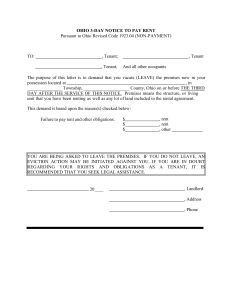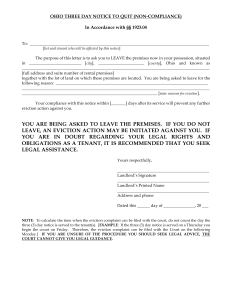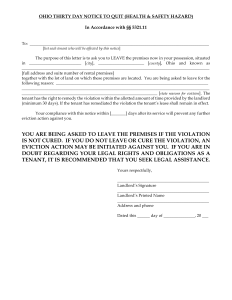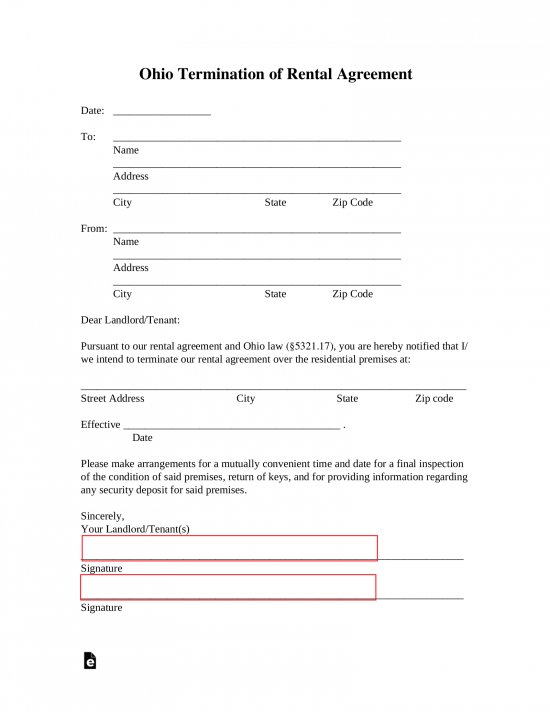By Type (4)
 3-Day Notice to Quit (Non-Payment of Rent) – Used to notify a tenant they have failed to pay rent when it is due. The tenant will have three days to respond before the landlord can proceed with an eviction action. 3-Day Notice to Quit (Non-Payment of Rent) – Used to notify a tenant they have failed to pay rent when it is due. The tenant will have three days to respond before the landlord can proceed with an eviction action.
Download: PDF, MS Word, OpenDocument |
 3-Day Notice to Quit (Non-Compliance) – Used to notify a tenant that they are violating a lease term other than not paying rent. The tenant will have three days to respond. 3-Day Notice to Quit (Non-Compliance) – Used to notify a tenant that they are violating a lease term other than not paying rent. The tenant will have three days to respond.
Download: PDF, MS Word, OpenDocument |
 30-Day Notice to Quit (Health or Safety Violation) – If a tenant is in violation of a health or safety code, the landlord can deliver this notice instructing the tenant to fix the problem or vacate the premises. 30-Day Notice to Quit (Health or Safety Violation) – If a tenant is in violation of a health or safety code, the landlord can deliver this notice instructing the tenant to fix the problem or vacate the premises.
Download: PDF, MS Word, OpenDocument |
 30-Day Notice to Quit (Month-to-Month Tenancy) – Used to inform a party that a month-to-month tenancy will not be renewed. 30-Day Notice to Quit (Month-to-Month Tenancy) – Used to inform a party that a month-to-month tenancy will not be renewed.
Download: PDF |
Prohibited Landlord Actions
Utility Shutoff – Any landlord who terminates a tenant’s utility services as a means to kick them out is liable for damages caused to the tenant, as well as attorney fees.[7]
Changing the Locks – Any landlord who unlawfully excludes a tenant from the premises is liable for damages caused to the tenant, as well as attorney fees.[7]
Court Forms
The below court forms are only applicable for use in Cuyahoga County, Cleveland. If the eviction is taking place in another county, the landlord or tenant must obtain the necessary paperwork from their local municipal court.
Notice to Leave Premises – Provides the tenant with three days’ notice to vacate the premises after failing to pay rent or other non-compliance with the lease.
Notice to Terminate Tenancy – Landlords may serve this notice upon monthly tenants to notify them that their tenancy will expire in 30 days.
24 Hour Notice – Informs the tenant that the landlord will access their unit within 24 hours.
Complaint in Forcible Entry and Detainer – Filed by the landlord after serving the tenant the appropriate notice period to vacate.
Defendant’s Answer (Sample of page 4) – Used by the tenant to respond to an eviction complaint filed against them. Must be filed within 28 days after receiving a court summons.
How to Evict a Tenant (4 steps)
2. File Complaint with Local Court
If the tenant does not move or cure the problem within the time period allowed, a landlord may proceed to the Local Municipal or County Court and obtain a Complaint. In Ohio, each court has its own form and process, so it is important that you ascertain what the requirements are for the court you are in.
Filing fees vary by municipality. For example:
3. Wait for Tenant’s Answer
Once you have filed a complaint, the court will issue a Summons and a copy of the Complaint to the tenant. The tenant will have 28 days from receipt of the Summons to respond and file the Answer.
4. Attend Hearing
The landlord should make sure to have copies of the notice, evidence that it was delivered, as well as copies of documents that show the breach by the tenant. If the tenant does not show up when instructed and/or the judge finds in favor of the landlord, the court will issue a Writ of Restitution which gives the tenant a certain number of days to vacate.
Video
Sources
- Ohio Rev. Code § 1923.02(B)
- Ohio Rev. Code § 1923.04(A)
- Ohio Rev. Code § 1923.04(A)(9)
- Ohio Rev. Code § 5321.11
- Ohio Rev. Code § 5321.17(B)
- Ohio Rev. Code Chapter 1923
- Ohio Rev. Code § 5321.15
- Franklin County Municipal Court – Accounting Finance Division
- Eviction Filing Checklist – Cleveland Municipal Court
- Hamilton County Municipal Civil Fees
